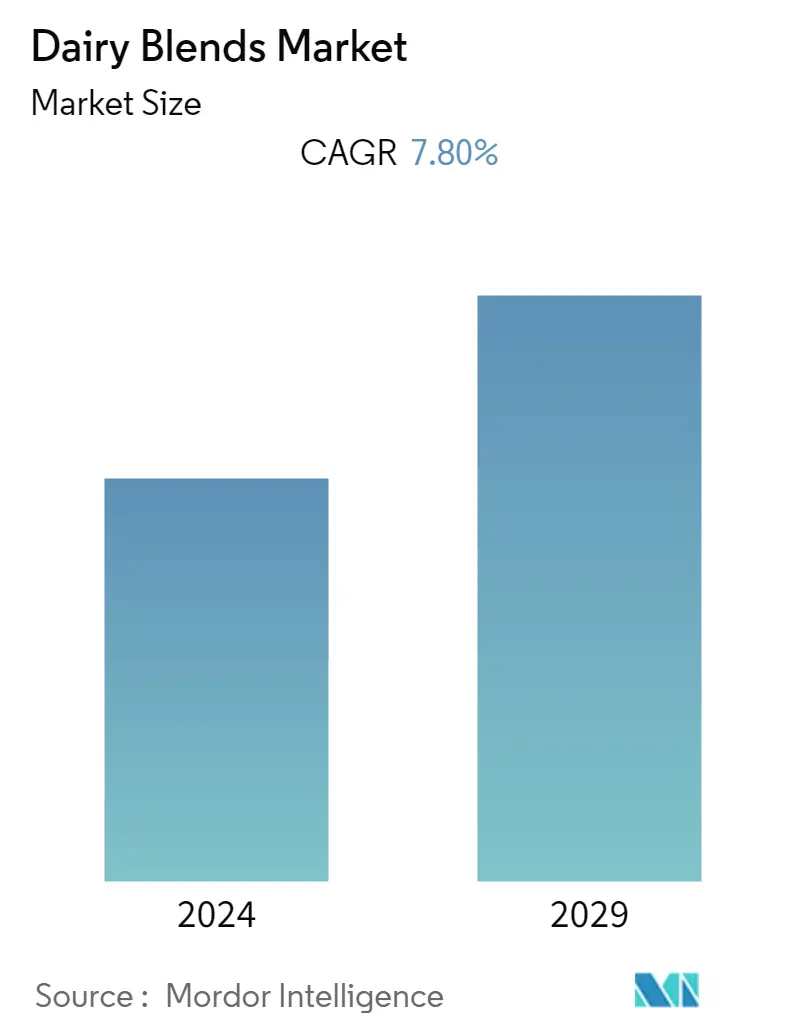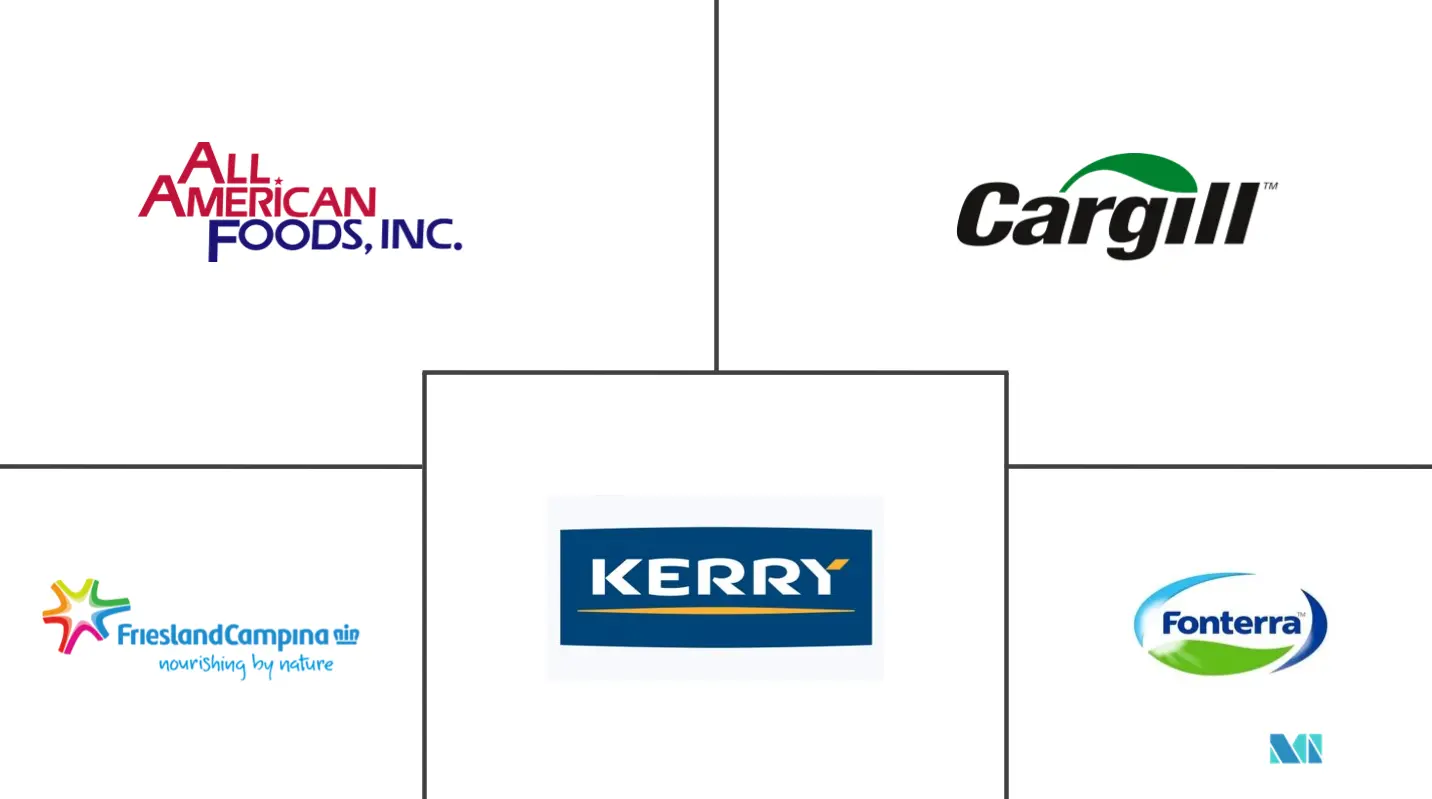Market Size of Dairy Blends Industry

| Study Period | 2019 - 2029 |
| Base Year For Estimation | 2023 |
| CAGR | 7.80 % |
| Fastest Growing Market | Asia Pacific |
| Largest Market | North America |
| Market Concentration | Low |
Major Players
*Disclaimer: Major Players sorted in no particular order |
Dairy Blends Market Analysis
The dairy blends market is projected to register a CAGR of 7.8% during the forecast period (2023-2028).
The COVID-19 outbreak had a negligible negative impact on the dairy blends market. As they are essentially used in the food and beverage sector, the demand for dairy blends increased due to the demand for different processed foods. According to the International Trade Administration (ITA), in 2019, the Chinese food and beverage industry experienced a 7.8% increase than in 2018, with an expected growth of 16% in 2021. The food and beverage sector and the constant demand for infant solutions added to the stable demand for dairy blends.
The increasing health consciousness among customers and the nutritional benefits of these products have encouraged the consumers to opt for dairy blends, as they have various health benefits like enhanced immune function and a reduced risk of several diseases, like diabetes. The presence of essential nutrients with lesser fat content adds to the surging growth of dairy blends in the market.
The availability of numerous flavors also fuels the demand for dairy blends. Companies are trying to experiment with various combinations of flavors to cater to the growing demand for innovation. Moreover, dairy blends can be used in various forms in different industries. For instance, powdered dairy blends can be used as sweeteners and stabilizers in many yogurts and ice creams.
Dairy Blends Industry Segmentation
Dairy blends are used by industries like food and beverage, nutrition, and infant solutions to prepare dairy protein products. These dairy blends are majorly used as functional ingredients and as a mixture of non-dairy and dairy ingredients. The dairy blends market is segmented by application and geography. Based on Application, the market is segmented into food, beverages, infant formula, and other applications. Furthermore, food application is bifurcated into the bakery, confectionery, ice cream, and yogurt. On the basis of geography, the dairy blends market is segmented into North America, Europe, Asia-Pacific, South America, and Middle East & Africa. For each segment, the market sizing and forecast have been done based on value (in USD million).
| Application | |||||||
| |||||||
| Beverages | |||||||
| Infant Formula | |||||||
| Other Application |
| Geography | |||||||||
| |||||||||
| |||||||||
| |||||||||
| |||||||||
|
Dairy Blends Market Size Summary
The dairy blends market is experiencing significant growth, driven by increasing health consciousness and the nutritional benefits these products offer. Dairy blends, which combine non-dairy and dairy ingredients, are gaining popularity for their enhanced immune function and reduced disease risk benefits. The market is further fueled by the diverse flavor options available, as companies innovate to meet consumer demand for variety. These blends are extensively used in the food and beverage industry, serving as functional ingredients in processed foods, and are also in high demand for infant formula. The rising interest in protein-rich dairy blends, such as whey protein, is particularly notable in the nutraceutical sector, contributing to the market's expansion.
The Asia-Pacific region is anticipated to witness the highest growth in the dairy blends market, attributed to the increasing preference for dairy-based products and the natural taste of milk fat compared to vegetable fats. The region's robust milk production, especially in countries like India, supports this growth. The market is highly competitive, with numerous domestic and global players like All American Foods, Kerry Group, and Cargill leading the charge. These companies are focusing on product differentiation and cost-efficient solutions to maintain their market positions. Recent innovations, such as new protein ingredients for infant formula and yogurt cultures, highlight the ongoing efforts to cater to evolving industry needs and expand the application of dairy blend ingredients.
Dairy Blends Market Size - Table of Contents
-
1. MARKET DYNAMICS
-
1.1 Market Drivers
-
1.2 Market Restraints
-
1.3 Porter's Five Forces Analysis
-
1.3.1 Threat of New Entrants
-
1.3.2 Bargaining Power of Buyers/Consumers
-
1.3.3 Bargaining Power of Suppliers
-
1.3.4 Threat of Substitute Products
-
1.3.5 Intensity of Competitive Rivalry
-
-
-
2. MARKET SEGMENTATION
-
2.1 Application
-
2.1.1 Food
-
2.1.1.1 Bakery
-
2.1.1.2 Confectionery
-
2.1.1.3 Ice Cream
-
2.1.1.4 Cheese
-
2.1.1.5 Yogurt
-
-
2.1.2 Beverages
-
2.1.3 Infant Formula
-
2.1.4 Other Application
-
-
2.2 Geography
-
2.2.1 North America
-
2.2.1.1 United States
-
2.2.1.2 Canada
-
2.2.1.3 Mexico
-
2.2.1.4 Rest of North America
-
-
2.2.2 Europe
-
2.2.2.1 United Kingdom
-
2.2.2.2 Germany
-
2.2.2.3 France
-
2.2.2.4 Russia
-
2.2.2.5 Italy
-
2.2.2.6 Spain
-
2.2.2.7 Rest of Europe
-
-
2.2.3 Asia-Pacific
-
2.2.3.1 India
-
2.2.3.2 China
-
2.2.3.3 Japan
-
2.2.3.4 Australia
-
2.2.3.5 Rest of Asia-Pacific
-
-
2.2.4 South America
-
2.2.4.1 Brazil
-
2.2.4.2 Argentina
-
2.2.4.3 Rest of South America
-
-
2.2.5 Middle-East and Africa
-
2.2.5.1 United Arab Emirates
-
2.2.5.2 South Africa
-
2.2.5.3 Rest of Middle-East and Africa
-
-
-
Dairy Blends Market Size FAQs
What is the current Dairy Blends Market size?
The Dairy Blends Market is projected to register a CAGR of 7.80% during the forecast period (2024-2029)
Who are the key players in Dairy Blends Market?
All American Foods, Kerry Group, Royal Frieslandcampina N.V., Cargill Inc. and Royal Frieslandcampina NV are the major companies operating in the Dairy Blends Market.

